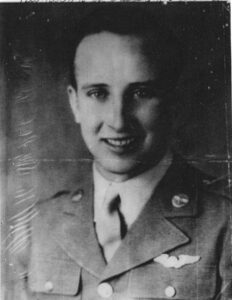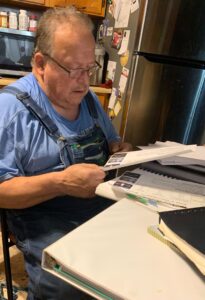The side streets and a country highway were lined with flags as a three-mile-long procession of hundreds wound its way to Highland Cemetery on Aug. 6. Children stood at attention. Grateful citizens parked by the roadside, solemnly paying their respects to a young man not a single living person present had ever met. Tech Sgt. Lawrence Reitz, “Ritzy” to his brothers-in-arms, came home to a tiny town in Indiana for a well-deserved eternal rest. First reported as KIA by the US War Department in 1943, then rumored to be a POW, Reitz and his long and mysterious journey were finally discovered and confirmed by DNA testing. After 80 years, endless searches, and promises made by family, he was coming home.
The pomp and circumstance for this young soldier were poignant and befitting a national hero — but none of it was planned or paid for by the Reitz family. Folks just showed up. Five fire trucks from surrounding rural areas led more than 100 cars and the hearse. Veterans riding motorcycles and waving flags followed, along with the Indiana State Police, local county sheriff, and deputies. Reitz’ flag-draped coffin was then transferred to a horse-drawn caisson for the final leg of the journey. It was a traditional military ceremony with honors, with a 21-gun salute, bugled Taps, and a B-52 flyover.
Try that in a big town — for a stranger. But as Jason Aldean’s song reminds us, now holding steady on Billboard’s number 1 spot, there are no strangers in a small town.
A Long, Lonely Journey
 It was in 1943, and the mission was Operation Tidal Wave, often called the “bloodiest air battle” of World War II. Out of the 178 B-24s that took part, only 88 returned to the strategic air base in Libya. More than 300 airmen were listed as killed or missing following the bombing raid in Ploiesti, north of Bucharest. Reitz, the radio operator on the Damfino, was one who never returned.
It was in 1943, and the mission was Operation Tidal Wave, often called the “bloodiest air battle” of World War II. Out of the 178 B-24s that took part, only 88 returned to the strategic air base in Libya. More than 300 airmen were listed as killed or missing following the bombing raid in Ploiesti, north of Bucharest. Reitz, the radio operator on the Damfino, was one who never returned.
Confusion reigned. It would take Ida Mae and Arnot Reitz, the soldier’s parents, on their own mission to find the truth. During the war, the bodies of troops killed were buried in place until it was safe to recover and return them home. That wasn’t possible until September 1945. The publication of the XPW Bulletin in 1944 turned grief into hope for Arnot and Ida Mae. Their son was mentioned as a German POW by former prisoners. The news sent the Reitz family down a path for the next 15 years.

Tech Sgt. Lawrence Reitz (Photo courtesy of the Reitz family)
Hundreds of pages of correspondence* with the War Department, reported sightings of Lawrence, and news in military circles convinced Ida Mae her son was alive and being held captive. Once the war was over, she traveled on extended stays to Europe, pleading with Germany to look into her son’s disappearance. A tip that Lawrence was enslaved in Vorkuta Corrective Labor Camp sent her to the Russian Embassy and more futile searches that she repeated for over a decade. In a gesture of friendship, she presented Russian dignitaries with a gift: 18 pounds of sweet corn seed — the best seed available — with directions on how and where to plant them. Ida told Stars and Stripes in June 1956: “When I presented it at the embassy, the official let the kernels run over his hand and stared. I told him the corn would produce 100 bushels to the acre. He thought it was wonderful.” Nevertheless, the Russians insisted they did not and never had Lawrence in their prison or POW system.
Ida Mae passed away in 1960 without knowing what had happened to her son. Arnot followed in 1965. But in May 2023, a DNA test found where Lawrence had been all along: in an unmarked grave, unidentifiable until now, in Bolovan Cemetery, Ploiesti, Romania.
Catering by Covered Dish for Reitz
The American Legion Post was the gathering place after the service concluded. Notebooks filled with the correspondence that spanned 80 years were neatly preserved in binders, and photos of the young serviceman dotted the red, white, and blue tables. The community, again, was there to support the Reitz family. Catering was by covered dish, as they say in the Heartland, and comfort food occupied the entire kitchen. Yes, coffee and sweet tea were in abundance.

Don Reitz (Photo courtesy of the Reitz family)
And that’s where Liberty Nation caught up with attendees and family members.
The “Do you know the family?” question was often answered with a “No, but we are here to pay tribute to a fallen soldier.” Steve and Brenda McIntosh explained that paying respects to a local boy was “the least we can do. He made it possible — like so many others — for us to be here.” It was Steve that welled up as the caisson had quietly rolled by earlier.
We talked with an emotional and grateful Donald Ray Reitz of Independence: Lawrence’s half-brother. He explained that he provided a DNA sample to bring home his brother, whom he had never met. “I’m blown away by all of this today. The community turned out. Everyone turned out. And we didn’t call around or ask. People just showed up. All for a no-name farm boy — not the son of a governor or senator.” And Reitz explained: “It’s all gratis. It’s all amazing.”
No one gave up on this soldier. And now, Sgt. Lawrence Reitz is home with his family, and his farewell will forever touch the tiny community.
“I promised my dad I would never give up,” Reitz told us. “And I lived long enough to keep that promise, to bring my brother home and bury him next to our dad.”
* Most of the information was first person and correspondence from the family with the US War Department over the last 80 years.
All opinions expressed are those of the author and do not necessarily represent those of Liberty Nation.
Do you have an opinion about this article? We’d love to hear it! If you send your comments to [email protected], we might even publish your edited remarks in our new feature, LN Readers Speak Out. Remember to include the title of the article along with your name, city, and state.
Please respect our republishing guidelines. Republication permission does not equal site endorsement. Click here

